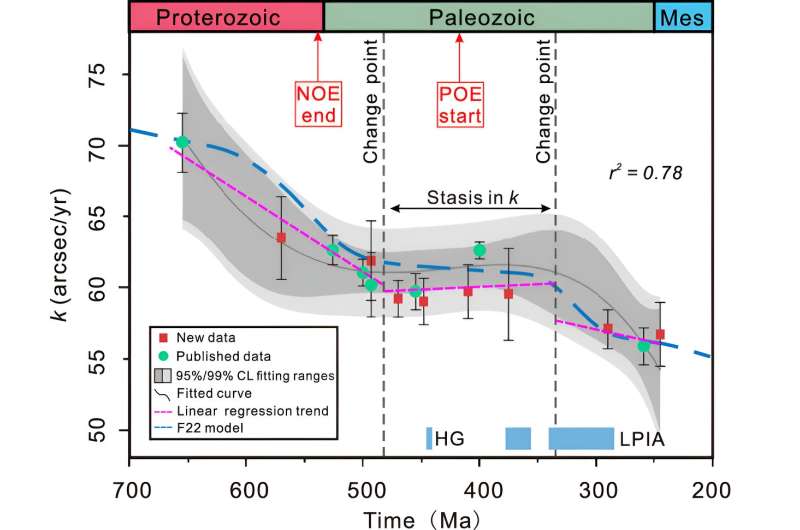August 16, 2024 report
This article has been reviewed according to Science X's editorial process and policies. Editors have highlighted the following attributes while ensuring the content's credibility:
fact-checked
peer-reviewed publication
trusted source
proofread
Study of Earth's rotation history shows deceleration has been in a staircase pattern

A multi-institutional team of geoscientists has found evidence that the Earth's rotation slows in a staircase pattern, with two stable periods that stand out. In their study, published in the Proceedings of the National Academy of Sciences, the group analyzed sediment sample data going back more than a half-billion years.
Prior research has shown Earth's axial spin is decreasing due mostly to tidal dissipation, but as the researchers with this new effort noted, the deceleration rate has not been consistently charted. In this effort, they attempted to achieve that by looking back 650 million years.
The researchers analyzed eight geological datasets compiled over many decades. These sedimentary archives offer not just geographic history, but evidence of the Earth's rotational history. The datasets covered the period from 280 to 650 million years ago.
The timeline reveals that it has not been a smooth deceleration; instead, Earth has experienced a series of slowdowns followed by stability, resulting in a staircase pattern. The researchers also found two notable stable periods, one that coincided with the Cambrian explosion, which led to a massive increase in wildlife diversity, and another that coincided with the largest known mass extinction. They suggest the periods following the two slowdowns may have been more than coincidental.
The data also confirmed that except for modern times, when humans have disrupted the global environment, deceleration has been due to tidal dissipation—the dissipation of orbital and rotational energy as heat in either the surface ocean, the interior of the planet, or the moon. Tidal heating occurs when the moon stretches and compresses as it gets closer to Earth.
The research team also found that during the period under study, the distance of the moon from the Earth was approximately 20,000 kilometers farther than it is today, and Earth days were approximately 2.2 hours longer. The research team plans to continue their work, looking for links between changes to Earth's rotation and major environmental events.
More information: He Huang et al, Geological evidence reveals a staircase pattern in Earth's rotational deceleration evolution, Proceedings of the National Academy of Sciences (2024). DOI: 10.1073/pnas.2317051121
Journal information: Proceedings of the National Academy of Sciences
© 2024 Science X Network





















